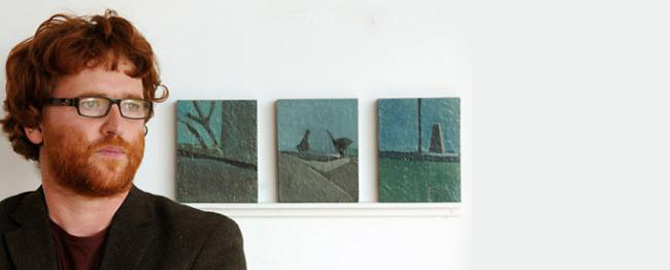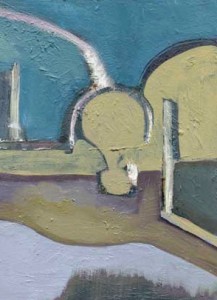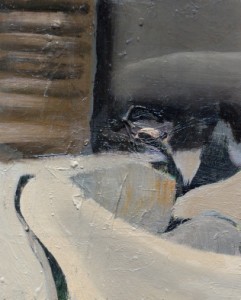Tom Palin works on small scale, refraining from large-scale imagery. His paintings, at first glance, are muted and dull images. However, the scale of the paintings draw the viewer in, enabling us to appreciate the occasional bright colours juxtaposed the muted pallet.
Palin’s work are interesting snaps shots of landscape, memory, poetry and his life experiences. His paintings shift, blurring ‘abstracted’ and ‘figurative’ subject matters, fusing them together through the use of paint. Despite the scale, there is a strong presence of bold use of mark-making and vigorous textures.
Palin frequently exhibits in the North-East of England, where his lives, paints and encourages people to explore and flourish their creativity.
In His own words
Why are you an artist? Did you ever feel that you had a choice?
At the age of 4 my uncle introduced me to acrylic paint. At playschool, as is the case with most kids, I made lots of paintings with ready mixed and powder paint, making my poor mum carry the dripping creations home. Later, in primary school, I began to be identified by teachers and other kids as one of those who is ‘good’ at art, especially at painting landscapes. I was very enthusiastic and keen to draw and paint regularly, sometimes making pictures for other people. I loved the seemingly magical potential of drawing. To me, it could open up new worlds of the imagination. I wanted to do more of it in the future. From then on I never thought in terms of choice.
You’re well known for working on small scale. In your opinion, how does the scale of the work effect the subject matter?
As a student of Fine Art (in Liverpool in the mid 1990s) I increasingly felt the need to work large. Most contemporary painting was big, and I too desired to make big, gestural statements. In my final year I shared a studio with the painter Daniel Pulman, who at that time worked on un-stretched canvases pieced together and covering whole walls. His manner of painting and his poetic seriousness impressed me greatly, though the scale of his work opposed my intention to contain images and control gestures within the parameters of my body and reach. He once called my work ‘mythic’, which, although flattering, more appropriately applied to his work more than to mine. After graduation I had a strong urge to shrink the physical proportions of my paintings, in part the result of a desire to re-engage with the figure and to explore the idea of intimacy and a heightened the sense of place. Also, small paintings are less
immersive and can be more easily related to as objects, which has remained an interest of mine.
Where do you take inspiration from?
No doubt from poetry, painting, places and the course of life’s events. There was a time when paintings reminded me of the world around me. Now, I tend to liken the world around me to paintings. I’m reminded of paintings all the time. For many years I’ve worked largely from memory. By this I mean that I like to let the processes of involuntary memory determine, at least in part, the imagery that I then adopt. Being tied to the model for too long frustrates and limits me (or, I perceive it to be limiting of my intensions). Actually, the paintings could be seen as a form of dialogue between memory and the material of oil paint. A painting itself acts as a time capsule—the layering processes build a surface image yet contain traces of all that constitute the making of that image.
I always instil the importance of Drawing to my students, encouraging them to use drawing as the foundation to their work. What disciplines or media do you find integral to the work of an artist and why?
I encourage drawing, particularly more experimental approaches. Anything that facilitates a greater knowledge of the role media plays in image making (and in establishing a sense of place) is important. Also, media experimentation builds a vocabulary of possibilities, which in turn allows for greater versatility. In painting, I do like to remind students of the material possibilities of paint. Wet-in-wet painting is a marvellously alchemic thing, and oil paint allows for an extended period of possibility wherein change can occur. In workshops I like to encourage a freedom to generate ideas from minimal yet fairly prescribed beginnings. The student is both creator of and bystander to the processes (both mental and practical) out of which imagery and narratives evolve.
What role does the artist have in society?
This is difficult to answer. I’m not one to think in terms of usefulness, at least in terms of doing one thing for the sake of another. Thinking too far ahead tends to prevent a fuller engagement in the activities of making. However, being involved in arts education I believe strongly in the transformative potential of painting (and making more generally). It might be easier to approach this by contemplating a world without art—such a place, to me at least, would too easily encourage a neat alignment of cause with effect, night with morning and of right with wrong. In artistic terms, all destinations are merely descriptions. That which sits between and is held in play is what matters. Art encourages, even necessitates, a way of thinking that opens you to a more expansive arena of experience, one
less closely tied to the certainties that surround us. Accepting the certainty of uncertainty is a positive thing.
What art do you most identify with?
I love the beauty, fragility and poetry of Maurice Utrillo’s white paintings and the ambition and searing, yet illusory, openness of Van Gogh’s late work. I cast my painterly net wide: from ancient times to modern and contemporary. However, the great masters of oil painting continually reward me. I tend to respond most to painters who use the artifice of painting to negate artificiality (Van Eyck, Titian, Giorgione, Bruegel, Rubens, Rembrandt, Vermeer, Constable, Friedrich, Chardin and Morandi among others). Painters who work within certain (often self-imposed) restrictions extend the possibilities of painting. Contemporary painters at times forget the importance of imposing a discipline on practice or of working with and through the medium itself, whether the result is abstract or
figurative (terms often misunderstood). Today, image-led painting tends to dominate, its seductive immediacy offering an attractive substitute for a more prolonged engagement with the material of paint.
What work do you most enjoying doing, and why?
I began with great enjoyment in making—the making of paintings and drawings and my reflection on that making were seemingly instantaneous. I went through a period of disliking the process (in part a fear of wantonly indulging in pushing paint around for its own sake). Now, again, I paint and watch at the same time. I’m less frustrated with delays in arriving at ‘finished’ work. I’m more patient and open to the possibility of nothing happening. Exhibiting work, however, involves different skills. Here, I welcome a greater detachment and I happily indulge in processes of selection and editing, grouping together works, writing rationales and statements and documenting experiences. To me, painting can now be more than it once was. On bad days I sense it to be less, but today I’m feeling optimistic. To put it another way, I can now enjoy paintings on varying levels. Painting gives me an outlet for my experiences that is reassuring and is mine. Whatever the factors are that determine my paintings, they happen to be siphoned through me. This is important.
Tom Palin (born 1974) is an award winning painter and educator based in the North West of England. He graduated from Liverpool John Moores University in Fine Art in 1996, and from the University of Manchester with an MA in Art History in 2006. He has exhibited his work in a number of solo and collaborative exhibitions, including solo shows at View 2 Gallery (Liverpool, 2008), Dean Clough Galleries (Halifax, 2005) and at The Atkinson Art Gallery, (Southport, 2004).
All images courtesy of Tom Palin | www.tompalin.co.uk
For more information on Hong Kong Art Tutoring please contact Gail Deayton at +852 9722 8353 or email: gd@gaildeayton.com









